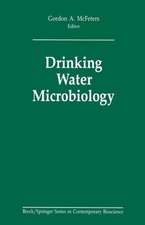The Physical Processes of Digestion
Autor Roger G. Lentle, Patrick W. M. Janssenen Limba Engleză Hardback – 7 iun 2011
| Toate formatele și edițiile | Preț | Express |
|---|---|---|
| Paperback (1) | 640.24 lei 6-8 săpt. | |
| Springer – 26 noi 2014 | 640.24 lei 6-8 săpt. | |
| Hardback (1) | 644.95 lei 6-8 săpt. | |
| Springer – 7 iun 2011 | 644.95 lei 6-8 săpt. |
Preț: 644.95 lei
Preț vechi: 758.77 lei
-15% Nou
Puncte Express: 967
Preț estimativ în valută:
123.43€ • 127.51$ • 102.72£
123.43€ • 127.51$ • 102.72£
Carte tipărită la comandă
Livrare economică 25 martie-08 aprilie
Preluare comenzi: 021 569.72.76
Specificații
ISBN-13: 9781441994486
ISBN-10: 1441994483
Pagini: 292
Ilustrații: IX, 279 p.
Dimensiuni: 155 x 235 x 20 mm
Greutate: 0.54 kg
Ediția:2011
Editura: Springer
Colecția Springer
Locul publicării:New York, NY, United States
ISBN-10: 1441994483
Pagini: 292
Ilustrații: IX, 279 p.
Dimensiuni: 155 x 235 x 20 mm
Greutate: 0.54 kg
Ediția:2011
Editura: Springer
Colecția Springer
Locul publicării:New York, NY, United States
Public țintă
ResearchCuprins
Foreword.- 1. Introduction.- Part I. The Digestion of Particle Suspensions.- 2. Microstructure and Digestion of Particles.- 3. Physical Aspects of the Digestion of Carbohydrate Particles.- 4. Physical Aspects of the Digestion of Protein Particles.- 5. Colloidal Dynamics and Lipid Digestive Efficiency.- 6. Physical Characteristics of Digesta.- Part II. The Effects of Contractile Activity of the Gut Wall and Its Structure on the Mixing and Absorption of Digesta.- 7. Contractile Activity and Control of the Physical Process of Digestion within a Gut Segment.- 8. Local Motility, Flow and Mixing in Tubular Segments of the Gut.- 9. Local Motility and Flow in Segments that Exhibit Volume Retention.- 10. Flow, Mixing and Absorption at the Mucosa.- Index.
Notă biografică
<b>Roger Lentle</b> graduated in medicine and in biochemistry from University College London and gained his PhD at Massey University, New Zealand. He has published extensively on the physical processes of digestion and is Professor of Digestive Biomechanics at the Institute of Food Nutrition and Human Health at Massey University.<P>
<b>Patrick Janssen</b> gained his PhD in chemical and process engineering at Canterbury University, New Zealand. He worked in the fields of process control and milk fat processing in the dairy industry before developing an interest in the physical processes of digestion. Currently he is a senior lecturer at the Institute of Food Nutrition and Human Health at Massey University.
<b>Patrick Janssen</b> gained his PhD in chemical and process engineering at Canterbury University, New Zealand. He worked in the fields of process control and milk fat processing in the dairy industry before developing an interest in the physical processes of digestion. Currently he is a senior lecturer at the Institute of Food Nutrition and Human Health at Massey University.
Textul de pe ultima copertă
This book is aimed at physiologists, pharmacologists, nutritionists and food technologists whose work requires an understanding of the physical processes of digestion. <P>
The book provides an overview of what is known of the physical processes of digestion in man and other simple-stomached vertebrates in two broad sections. The first section considers the physical constraints that govern the dissolution and digestion of the various macronutrients within food particles, and the physical factors that influence their subsequent transfer to the gut wall, notably the rheology and permeability of digesta. The second section examines the effects of the alimentary, mechanical and biophysical processes on mixing and mass transfer. Included is a comprehensive review of the effects of the various types of contractile activity in the gut wall in securing efficient mixing and onflow of digesta through the various segments of the gut. The section also examines what is known of the actions of the mucinous and cellular components of the gut wall in lubricating the passage of digesta and in limiting the permeation and absorption of nutrients, pharmaceuticals and microbial products. The section concludes with a review of the effects of the various physical and morphological components of the gut wall that constitute the ‘unstirred water layer’ on the process of absorption. <P>
The authors are leaders in their field and have extensively researched the literature. The work cites over 1500 references including those pertaining to the latest developments.
The book provides an overview of what is known of the physical processes of digestion in man and other simple-stomached vertebrates in two broad sections. The first section considers the physical constraints that govern the dissolution and digestion of the various macronutrients within food particles, and the physical factors that influence their subsequent transfer to the gut wall, notably the rheology and permeability of digesta. The second section examines the effects of the alimentary, mechanical and biophysical processes on mixing and mass transfer. Included is a comprehensive review of the effects of the various types of contractile activity in the gut wall in securing efficient mixing and onflow of digesta through the various segments of the gut. The section also examines what is known of the actions of the mucinous and cellular components of the gut wall in lubricating the passage of digesta and in limiting the permeation and absorption of nutrients, pharmaceuticals and microbial products. The section concludes with a review of the effects of the various physical and morphological components of the gut wall that constitute the ‘unstirred water layer’ on the process of absorption. <P>
The authors are leaders in their field and have extensively researched the literature. The work cites over 1500 references including those pertaining to the latest developments.
Caracteristici
Thorough overview of the current state of knowledge regarding the physical processing of food and nutrients within the gastrointestinal tract An examination of the biological factors that influence mixing and absorption of nutrients Several chapters contributed by recognized experts
























